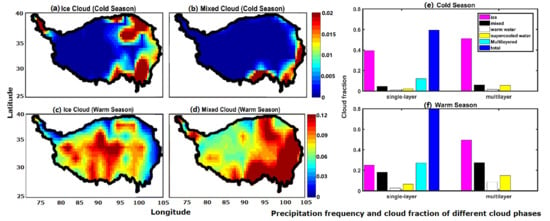Climatology of Cloud Phase, Cloud Radiative Effects and Precipitation Properties over the Tibetan Plateau
Abstract
1. Introduction
2. Materials and Methods
2.1. CALIOP Instrumentation Aboard CALIPSO
2.2. The CPR Instrument Aboard CloudSat
2.3. Satellite Products and Reanalysis Dataset
2.4. Methodology
3. Results
3.1. The CF and CRE of Different Cloud Phase over the TP
3.2. Regional Averaged Cloud Fraction and Radiative Contribution
3.3. Heating Rate Profiles of the Cloud Phase over the TP
3.4. Precipitation Frequency of Cloud Phase over the TP
4. Discussion
5. Conclusions
Supplementary Materials
Author Contributions
Funding
Data Availability Statement
Acknowledgments
Conflicts of Interest
References
- Harrison, E.F.; Minnis, P.; Barkstrom, B.R.; Ramanathan, V.; Cess, R.D.; Gibson, G.G. Seasonal variation of cloud radiative forcing derived from the earth radiation budget experiment. J. Geophys. Res. Atmos. 1990, 95, 18687–18703. [Google Scholar] [CrossRef]
- Stephens, G.L. Cloud feedbacks in a climate system: A critical review. J. Clim. 2005, 18, 237–273. [Google Scholar] [CrossRef]
- Lolli, S.; Campbell, J.R.; Lewis, J.R.; Gu, Y.; Marquis, J.W.; Chew, B.N.; Liew, S.C.; Salinas, S.V.; Welton, E.J. Daytime top-of-the-atmosphere cirrus cloud radiative forcing properties at Singapore. J. Appl. Meteorol. Clim. 2017, 56, 1249–1257. [Google Scholar] [CrossRef]
- Min, M.; Wang, P.C.; Campbell, J.R.; Zong, X.M.; Li, Y. Midlatitude cirrus cloud radiative forcing over China. J. Geophys. Res. Atmos. 2010, 115, D20. [Google Scholar] [CrossRef]
- Klein, S.A.; Hartmann, D.L. The seasonal cycle of low stratiform clouds. J. Clim. 1993, 6, 1587–1606. [Google Scholar] [CrossRef]
- Myers, T.A.; Norris, J.R. Reducing the uncertainty in subtropical cloud feedback. Geophys. Res. Lett. 2016, 43, 2144–2148. [Google Scholar] [CrossRef]
- Li, J.; Lv, Q.; Zhang, M.; Wang, T.; Kawamoto, K.; Chen, S.; Zhang, B. Effects of atmospheric dynamics and aerosols on the fraction of supercooled water clouds. Atmos. Chem. Phys. 2017, 17, 1847–1863. [Google Scholar] [CrossRef]
- Zhang, M.H.; Lin, W.Y.; Klein, S.A.; Bacmeister, J.T.; Bony, S.; Cederwall, R.T.; Del Genio, A.D.; Hack, J.J.; Loeb, N.G.; Lohmann, U.; et al. Comparing clouds and 15 their seasonal variations in 10 atmospheric general circulation models with satellite measurements. J. Geophys. Res. Atmos. 2005, 110, D15S02. [Google Scholar]
- Cess, R.D.; Zhang, M.H.; Ingram, W.J.; Potter, G.L.; Alekseev, V.; Barker, H.W.; Cohen-Solal, E.; Colman, R.A.; Dazlich, D.A.; Del Genio, A.D.; et al. Cloud feedback in atmospheric general circulation models: An update. J. Geophys. Res. Atmos. 1996, 101, 12791–12794. [Google Scholar] [CrossRef]
- Boucher, O.; Randall, D.; Artaxo, P.; Bretherton, C.; Feingold, G.; Forster, P.; Kerminen, V.; Kondo, Y.; Liao, H.; Lohmann, U.; et al. Clouds and aerosols. In Climate Changes 2013: The Physical Science Basis; Contribution of Working Group 1 to the IPCC Fifth Assessment Report; Stocker, T.F., Qin, D., Plattner, G.K., Tignor, M., Allen, S.K., Boschung, J., Nauels, A., Xia, Y., Bex, V., Midgley, P.M., Eds.; Cambridge University Press: Cambridge, UK; New York, NY, USA, 2013; pp. 571–657. [Google Scholar]
- Fu, Q.; Liou, K.N. Parameterization of the radiative properties of cirrus clouds. J. Atmos. Sci. 1993, 50, 2008–2025. [Google Scholar] [CrossRef]
- Hu, Y.X.; Stamnes, K. An accurate parameterization of the radiative properties of water clouds suitable for use in climate models. J. Clim. 1993, 6, 728–742. [Google Scholar] [CrossRef]
- Deetz, K.; Vogel, H.; Haslett, S.; Knippertz, P.; Coe, H.; Vogel, B. Aerosol liquid water content in the moist southern West African monsoon layer and its radiative impact. Atmos. Chem. Phys. 2018, 18, 14271–14295. [Google Scholar] [CrossRef]
- Mülmenstädt, J.; Sourdeval, O.; Delanoë, J.; Quaas, J. Frequency of occurrence of rain from liquid-, mixed-, and ice-phase clouds derived from A-Train satellite retrievals. Geophys. Res. Lett. 2015, 42, 6502–6509. [Google Scholar] [CrossRef]
- Heymsfield, A.J.; Schmitt, C.; Chen, C.; Bansemer, A.; Gettelman, A.; Field, P.R.; Liu, C. Contributions of the liquid and ice phases to global surface precipitation: Observations and global climate modeling. J. Atmos. Sci. 2020, 77, 2629–2648. [Google Scholar] [CrossRef]
- Pruppacher, H.R.; Klett, J.D. Microphysics of clouds and precipitation. In Atmospheric and Oceanographic Sciences Library; Springer: Cham, Switzerland, 1997; Volume 18. [Google Scholar]
- Hong, Y.; Liu, G. The characteristics of ice cloud properties derived from CloudSat and CALIPSO measurements. J. Clim. 2015, 28, 3880–3901. [Google Scholar] [CrossRef]
- Shupe, M.D.; Daniel, J.S.; De Boer, G.; Eloranta, E.W.; Kollias, P.; Long, C.N.; Luke, E.P.; Turner, D.D.; Verlinde, J. A focus on mixed-phase clouds: The status of ground-based observational methods. Bull. Amer. Meteor. Soc. 2008, 89, 1549–1562. [Google Scholar] [CrossRef]
- Choi, Y.S.; Lindzen, R.S.; Kim, H.J. Space observations of cold-cloud phase change. Proc. Natl. Acad. Sci. USA 2010, 107, 11211–11216. [Google Scholar] [CrossRef]
- Morrison, H.; Zuidema, P.; Ackerman, A.S.; Avramov, A.; de Boer, G.; Fan, J.; Fridlind, A.M.; Hashino, T.; Harrington, J.Y.; Luo, Y.; et al. Intercomparison of cloud model simulations of Arctic mixed-phase boundary layer clouds observed during SHEBA/FIRE-ACE. J. Adv. Model. Earth. Syst. 2011, 3, M06003. [Google Scholar] [CrossRef]
- Tan, I.; Storelvmo, T.; Choi, Y.S. Spacebornelidar observations of the ice-nucleating potential of dust, polluted dust, and smoke aerosols in mixed-phase clouds. J. Geophys. Res. Atmos. 2014, 119, 6653–6665. [Google Scholar] [CrossRef]
- Cesana, G.; Storelvmo, T. Improving climate projections by understanding how cloud phase affects radiation. J. Geophys. Res. Atmos. 2017, 122, 4594–4599. [Google Scholar] [CrossRef]
- Pruppacher, H.R.; Klett, J.D.; Wang, P.K. Microphysics of clouds and precipitation. Aerosol. Sci. Tech. 1998, 28, 381–382. [Google Scholar] [CrossRef]
- Lohmann, U.; Henneberger, J.; Henneberg, O.; Fugal, J.P.; Bühl, J.; Kanji, Z.A. Persistence of orographic mixed-phase clouds. Geophys. Res. Lett. 2016, 43, 10512–10519. [Google Scholar] [CrossRef]
- Bodas-Salcedo, A.; Andrews, T.; Karmalkar, A.V.; Ringer, M.A. Cloud liquid water path and radiative feedbacks over the Southern Ocean. Geophys. Res. Lett. 2016, 43, 10938–10946. [Google Scholar] [CrossRef]
- Sun, Z.; Shine, K.P. Studies of the radiative properties of ice and mixed-phase clouds. Q. J. Roy. Meteor. Soc. 1994, 120, 111–137. [Google Scholar] [CrossRef]
- Shupe, M.D.; Matrosov, S.Y.; Uttal, T. Arctic mixed-phase cloud properties derived from surface-based sensors at SHEBA. J. Atmos. Sci. 2006, 63, 697–711. [Google Scholar] [CrossRef]
- Sun, Z.; Shine, K.P. Parameterization of ice cloud radiative properties and its application to the potential climatic importance of mixed-phase clouds. J. Clim. 1995, 8, 1874–1888. [Google Scholar] [CrossRef]
- Bodas-Salcedo, A.; Hill, P.G.; Furtado, K.; Williams, K.D.; Field, P.R.; Manners, J.C.; Hyder, P.; Kato, S. Large contribution of supercooled liquid clouds to the solar radiation budget of the Southern Ocean. J. Clim. 2016, 29, 4213–4228. [Google Scholar] [CrossRef]
- Matus, A.V.; L’Ecuyer, T.S. The role of cloud phase in Earth’s radiation budget. J. Geophys. Res. Atmos. 2017, 122, 2559–2578. [Google Scholar] [CrossRef]
- Stephens, G.L.; Greenwald, T.J. The Earth’s radiation budget and its relation to atmospheric hydrology: 2. Observations of cloud effects. J. Geophys. Res. Atmos. 1991, 96, 15325–15340. [Google Scholar] [CrossRef]
- Hartmann, D.L.; Ockert-Bell, M.E.; Michelsen, M.L. The effect of cloud type on Earth’s energy balance: Global analysis. J. Clim. 1992, 5, 1281–1304. [Google Scholar] [CrossRef]
- McFarquhar, G.M.; Heymsfield, A.J.; Spinhirne, J.; Hart, B. Thin and subvisual tropopause tropical cirrus: Observations and radiative impacts. J. Atmos. Sci. 2000, 57, 1841–1853. [Google Scholar] [CrossRef]
- Hang, Y.; L’Ecuyer, T.S.; Henderson, D.S.; Matus, A.V.; Wang, Z. Reassessing the effect of cloud type on Earth’s energy balance in the age of active spaceborne observations. Part II: Atmospheric heating. J. Clim. 2019, 32, 6219–6236. [Google Scholar] [CrossRef]
- L’Ecuyer, T.S.; Hang, Y.; Matus, A.V.; Wang, Z. Reassessing the effect of cloud type on Earth’s energy balance in the age of active spaceborne observations. Part I: Top-of-atmosphere and surface. J. Clim. 2019, 32, 6197–6217. [Google Scholar] [CrossRef]
- Komurcu, M.; Storelvmo, T.; Tan, I.; Lohmann, U.; Yun, Y.; Penner, J.E.; Wang, Y.; Liu, X.; Takemura, T. Intercomparison of the cloud water phase among global climate models. J. Geophys. Res. Atmos. 2014, 119, 3372–3400. [Google Scholar] [CrossRef]
- Cesana, G.; Kay, J.E.; Chepfer, H.; English, J.M.; De Boer, G. Ubiquitous low-level liquid-containing Arctic clouds: New observations and climate model constraints from CALIPSO-GOCCP. Geophys. Res. Lett. 2012, 39, L20804. [Google Scholar] [CrossRef]
- Forbes, R.M.; Ahlgrimm, M. On the representation of high-latitude boundary layer mixed-phase cloud in the ECMWF global model. Mon. Weather. Rev. 2014, 142, 3425–3445. [Google Scholar] [CrossRef]
- Storelvmo, T.; Kristjansson, J.E.; Lohmann, U. Aerosol influence on mixed-phase clouds in CAM-Oslo. J. Atmos. Sci. 2008, 65, 3214–3230. [Google Scholar] [CrossRef]
- Xu, X.; Lu, C.; Shi, X.; Gao, S. World water tower: An atmospheric perspective. Geophys. Res. Lett. 2008, 35, L20815. [Google Scholar] [CrossRef]
- Yao, T.; Thompson, L.; Yang, W.; Yu, W.; Gao, Y.; Guo, X.; Yang, X.; Duan, K.; Zhao, H.; Xu, B.; et al. Different glacier status with atmospheric circulations in Tibetan Plateau and surroundings. Nat. Clim. Change 2012, 2, 663–667. [Google Scholar] [CrossRef]
- Cheng, G.; Wu, T. Responses of permafrost to climate change and their environmental significance, Qinghai-Tibet Plateau. J. Geophys. Res. 2007, 112, F02S03. [Google Scholar] [CrossRef]
- Zhu, L.P.; Xie, M.P.; Wu, X.Y. Quantitative analysis of lake area variations and the influence factors from 1971 to 2004 in the Nam Co basin of the Tibetan Plateau. Chinese. Sci. Bull. 2010, 55, 1294–1303. [Google Scholar] [CrossRef]
- Chen, B.; Chao, W.C.; Liu, X. Enhanced climatic warming in the Tibetan Plateau due to doubling CO2: A model study. Clim. Dynam. 2003, 20, 401–413. [Google Scholar] [CrossRef]
- Liu, X.; Cheng, Z.; Yan, L.; Yin, Z.Y. Elevation dependency of recent and future minimum surface air temperature trends in the Tibetan Plateau and its surroundings. Glob. Planet. Change. 2009, 68, 164–174. [Google Scholar] [CrossRef]
- Yang, K.; Ding, B.; Qin, J.; Tang, W.; Lu, N.; Lin, C. Can aerosol loading explain the solar dimming over the Tibetan Plateau. Geophys. Res. Lett. 2012, 39, L20710. [Google Scholar] [CrossRef]
- Duan, A.; Wu, G. Change of cloud amount and the climate warming on the Tibetan Plateau. Geophys. Res. Lett. 2006, 33, L22704. [Google Scholar] [CrossRef]
- Yan, Y.; Liu, Y.; Lu, J. Cloud vertical structure, precipitation, and cloud radiative effects over Tibetan Plateau and its neighboring regions. J. Geophys. Res. 2016, 121, 5864–5877. [Google Scholar] [CrossRef]
- Chen, J.; Wu, X.; Yin, Y.; Huang, Q.; Xiao, H. Characteristics of cloud systems over the Tibetan Plateau and East China during Boreal Summer. J. Clim. 2017, 30, 3117–3137. [Google Scholar] [CrossRef]
- Zhang, X.; Peng, L.; Zheng, D.; Tao, J. Cloudiness variations over the Qinghai-Tibet Plateau during 1971–2004. J. Geogr. Sci. 2008, 18, 142–154. [Google Scholar] [CrossRef]
- MacIntosh, C.R.; Allan, R.P.; Baker, L.H.; Bellouin, N.; Collins, W.; Mousavi, Z.; Shine, K.P. Contrasting fast precipitation responses to tropospheric and stratospheric ozone forcing. Geophys. Res. Lett. 2016, 43, 1263–1271. [Google Scholar] [CrossRef]
- Redemann, J.; Wood, R.; Zuidema, P.; Doherty, S.J.; Luna, B.; LeBlanc, S.E.; Diamond, M.S.; Shinozuka, Y.; Chang, I.Y.; Ueyama, R.; et al. An overview of the ORACLES (ObseRvations of Aerosols above CLouds and their intEractionS) project: Aerosol-cloud-radiation interactions in the Southeast Atlantic basin. Atmos. Chem. Phys. Discuss. 2020, 1–82. [Google Scholar] [CrossRef]
- Schmale, J.; Baccarini, A.; Thurnherr, I.; Henning, S.; Efraim, A.; Regayre, L.; Bolas, C.; Hartmann, M.; Welti, A.; Lehtipalo, K.; et al. Overview of the antarctic circumnavigation expedition: Study of preindustrial-like aerosols and their climate effects (ace-space). Bull. Am. Meteorol. Soc. 2019, 100, 2260–2283. [Google Scholar] [CrossRef]
- Winker, D.M.; Vaughan, M.A.; Omar, A.; Hu, Y.; Powell, K.A.; Liu, Z.; Hunt, W.H.; Young, S.A. Overview of the CALIPSO mission and CALIOP data processing algorithms. J. Atmos. Ocean. Tech. 2009, 26, 2310–2323. [Google Scholar] [CrossRef]
- Winker, D.M.; Pelon, J.R.; McCormick, M.P. CALIPSO mission: Spaceborne lidar for observation of aerosols and clouds. In Lidar Remote Sensing for Industry and Environment Monitoring III; Singh, U.N., Itabe, T., Liu, Z., Eds.; International Society for Optics and Photonics: Bellingham, WA, USA, 2003; pp. 1–11. [Google Scholar]
- Vaughan, M.A.; Powell, K.A.; Winker, D.M.; Hostetler, C.A.; Kuehn, R.E.; Hunt, W.H.; Getzewich, B.J.; Young, S.A.; Liu, Z.Y.; McGill, M.J. Fully automated detection of cloud and aerosol layers in the CALIPSO lidar measurements. J. Atmos. Ocean. Tech. 2009, 26, 2034–2050. [Google Scholar] [CrossRef]
- Young, S.A.; Vaughan, M.A. The retrieval of profiles of particulate extinction from Cloud Aerosol Lidar Infrared Pathfinder Satellite Observations (CALIPSO) lidar data: Algorithm description. J. Atmos. Ocean. Tech. 2009, 26, 1105–1119. [Google Scholar] [CrossRef]
- Wang, Z.; Vane, D.; Stephens, G.; Reinke, D. CloudSat Project: Level 2 Combined Radar and Lidar Cloud Scenario Classification Product Process Description and Interface Control Document; Cooperative Institute for Research in the Atmosphere: Fort Collins, CO, USA, 2013. [Google Scholar]
- Li, J.; Lv, Q.; Jian, B.; Zhang, M.; Zhao, C.; Fu, Q.; Kawamoto, K.; Zhang, H. The impact of atmospheric stability and wind shear on vertical cloud overlap over the Tibetan Plateau. Atmos. Chem. Phys. 2018, 18, 7329–7343. [Google Scholar] [CrossRef]
- Stephens, G.L.; Vane, D.G.; Boain, R.J.; Mace, G.G.; Sassen, K.; Wang, Z.; Lllingworth, A.J.; Oconnor, E.J.; Rossow, W.B.; Durden, S.L.; et al. THE CLOUDSAT MISSION AND THE A-TRAIN a new dimension of space-based observations of clouds and precipitation. Bull. Amer. Meteor. Soc. 2002, 83, 1771–1790. [Google Scholar] [CrossRef]
- Stephens, G.L.; Vane, D.G.; Tanelli, S.; Im, E.; Durden, S.; Rokey, M.; Reinke, D.; Partain, P.; Mace, G.G.; Austin, R.; et al. CloudSat mission: Performance and early science after the first year of operation. J. Geophys. Res. Atmos. 2008, 113, D00A18. [Google Scholar] [CrossRef]
- Matrosov, S.Y. Potential for attenuation-based estimations of rainfall rate from CloudSat. Geophys. Res. Lett. 2007, 34, 5. [Google Scholar] [CrossRef]
- Matrosov, S.Y.; Battaglia, A.; Rodriguez, P. Effects of multiple scattering on attenuation-based retrievals of stratiform rainfall from CloudSat. J. Atmos. Ocean. Tech. 2008, 25, 2199–2208. [Google Scholar] [CrossRef]
- Matrosov, S.Y.; Battaglia, A. Influence of multiple scattering on CloudSat measurements in snow: A model study. Geophys. Res. Lett. 2009, 36, 12. [Google Scholar] [CrossRef]
- Tanelli, S.; Durden, S.L.; Im, E.; Pak, K.S.; Reinke, D.G.; Partain, P.; Haynes, J.M.; Marchand, R.T. CloudSat’s cloud profiling radar after two years in orbit: Performance, calibration, and processing. IEEE Trans. Geosci. Remote. 2008, 46, 3560–3573. [Google Scholar] [CrossRef]
- Partain, P. Cloudsat ECMWF-AUX Auxiliary Data Process Description and Interface Control Document; Cooperative Institute for Research in the Atmosphere, Colorado State University: Fort Collins, CO, USA, 2004. [Google Scholar]
- L’Ecuyer, T.S.; Wood, N.B.; Haladay, T.; Stephens, G.L.; Stackhouse, P.W. Impact of clouds on atmospheric heating based on the R04 CloudSat fluxes and heating rates data set. J. Geophys. Res. Atmos. 2008, 113, D00A15. [Google Scholar] [CrossRef]
- CloudSat Projec. Level 2B Fluxes and Heating Rates with Lidar [2B-FLXHR-LIDAR] Process Description and Interface Control Document; Deptartment of Atmospheric Science, Colorado State University: Fort Collins, CO, USA, 2020. [Google Scholar]
- Henderson, D.S.; L’Ecuyer, T.; Stephens, G.; Partain, P.; Sekiguchi, M. A multi-sensor perspective on the radiative impacts of clouds and aerosols. J. Appl. Meteorol. Climatol. 2013, 52, 853–871. [Google Scholar] [CrossRef]
- Tian, L.; Curry, J.A. Cloud overlap statistics. J. Geophys. Res. Atmos. 1989, 94, 9925–9935. [Google Scholar] [CrossRef]
- Li, J.; Huang, J.; Stamnes, K.; Wang, T.; Lv, Q.; Jin, H. A global survey of cloud overlap based on CALIPSO and CloudSat measurements. Atmos. Chem. Phys. 2015, 15, 519–536. [Google Scholar] [CrossRef]
- Haynes, J.M. CloudSat 2C-PRECIP-COLUMN Data Product Process Description and Interface Control Document; Deptartment of Atmospheric Science, Colorado State University: Fort Collins, CO, USA, 2018. [Google Scholar]
- Haynes, J.M.; L’Ecuyer, T.; Stephens, G.L.; Miller, S.D.; Mitrescu, C.; Wood, N.B.; Tanelli, S. Rainfall retrievals over the ocean with spaceborne high-frequency cloud radar. J. Geophys. Res. 2009, 114, D8. [Google Scholar]
- Wang, J.; Geerts, B. Identifying drizzle within marine stratus with W-band radar reflectivity. Atmos. Res. 2003, 69, 1–27. [Google Scholar] [CrossRef]
- Liu, Y.; Geerts, B.; Miller, M.; Daum, P.; McGraw, R. Threshold radar reflectivity for drizzling clouds. Geophys. Res. Lett. 2008, 35, 3. [Google Scholar] [CrossRef]
- Dzambo, A.M.; L’Ecuyer, T.; Sy, O.O.; Tanelli, S. The observed structure and precipitation characteristics of southeast Atlantic stratocumulus from airborne radar during ORACLES 2016–17. J. Appl. Meteorol. Clim. 2019, 58, 2197–2215. [Google Scholar] [CrossRef]
- Huang, J.; Guan, X.; Ji, F. Enhanced cold-season warming in semi-arid regions. Atmos. Chem. Phys. 2012, 12, 4627–4653. [Google Scholar] [CrossRef]
- Kukulies, J.; Chen, D.; Wang, M. Temporal and spatial variations of convection and precipitation over the Tibetan Plateau based on recent satellite observations. Part I: Cloud climatology derived from CloudSat and CALIPSO. Int. J. Climatol. 2019, 39, 5396–5412. [Google Scholar] [CrossRef]
- Morrison, A.E.; Siems, S.T.; Manton, M.J.; Nazarov, A. A modeling case study of mixed-phase clouds over the Southern Ocean and Tasmania. Mon. Weather. Rev. 2010, 138, 839–862. [Google Scholar] [CrossRef]
- Baum, B.A.; Menzel, W.P.; Frey, R.A.; Tobin, D.C.; Holz, R.E.; Ackerman, S.A.; Heidinger, A.K.; Yang, P. MODIS cloud-top property refinements for collection 6. J. Appl. Meteorol. Clim. 2012, 51, 1145–1163. [Google Scholar] [CrossRef]
- Tan, I.; Storelvmo, T.; Zelinka, M.D. Observational constraints on mixed-phase clouds imply higher climate sensitivity. Science 2016, 352, 224–227. [Google Scholar] [CrossRef] [PubMed]
- Yuan, T.; Oreopoulos, L. On the global character of overlap between low and high clouds. Geophys. Res. Lett. 2013, 40, 5320–5326. [Google Scholar] [CrossRef]
- Hong, Y.; Liu, G.; Li, J.L. Assessing the radiative effects of global ice clouds based on CloudSat and CALIPSO measurements. J. Clim. 2016, 29, 7651–7674. [Google Scholar] [CrossRef]
- Zhao, C.; Liu, L.; Wang, Q.; Qiu, Y.; Wang, W.; Wang, Y.; Fan, T. Toward understanding the properties of high ice clouds at the Naqu site on the Tibetan Plateau using ground-based active remote sensing measurements obtained during a short period in July 2014. J. Appl. Meteor. Climatol. 2016, 55, 2493–2507. [Google Scholar] [CrossRef]
- Tsushima, Y.; Emori, S.; Ogura, T.; Kimoto, M.; Webb, M.J.; Williams, K.D.; Ringer, M.A.; Soden, B.J.; Li, B.; Andronova, N. Importance of the mixed-phase cloud distribution in the control climate for assessing the response of clouds to carbon dioxide increase: A multi-model study. Clim. Dyn. 2006, 27, 113–126. [Google Scholar] [CrossRef]
- McCoy, D.T.; Hartmann, D.L.; Zelinka, M.D.; Ceppi, P.; Grosvenor, D.P. Mixed-phase cloud physics and Southern Ocean cloud feedback in climate models. J. Geophys. Res. Atmos. 2015, 120, 9539–9554. [Google Scholar] [CrossRef]
- Gordon, N.D.; Klein, S.A. Low-cloud optical depth feedback in climate models. J. Geophys. Res. Atmos. 2014, 119, 6052–6065. [Google Scholar] [CrossRef]
- Li, X.; Che, H.; Wang, H.; Xia, X.; Chen, Q.; Gui, K.; Zhao, H.; An, L.; Zheng, Y.; Sun, T.; et al. Spatial and temporal distribution of the cloud optical depth over China based on MODIS satellite data during 2003–2016. J. Environ. Sci. 2019, 80, 66–81. [Google Scholar] [CrossRef] [PubMed]
- Bao, S.; Letu, H.; Zhao, C.; Tana, G.; Shang, H.; Wang, T.; Chen, B.; Bao, Y.; He, J.; Wang, T.; et al. Spatiotemporal distributions of cloud parameters and their response to meteorological factors over the Tibetan Plateau during 2003–2015 based on MODIS data. Int. J. Climatol. 2019, 39, 532–543. [Google Scholar] [CrossRef]
- Comstock, J.M.; Ackerman, T.P.; Mace, G.G. Ground-based lidar and radar remote sensing of tropical cirrus clouds at Nauru Island: Cloud statistics and radiative impacts. J. Geophys. Res. Atmos. 2002, 107, AAC16. [Google Scholar] [CrossRef]
- Schumacher, C.; Ciesielski, P.E.; Zhang, M.H. Tropical cloud heating profiles: Analysis from KWAJEX. Mon. Weather Rev. 2008, 136, 4289–4300. [Google Scholar] [CrossRef]
- Powell, S.W.; Houze, R.A.; Kumar, A.; Mcfarlane, S.A. Comparison of simulated and observed continental tropical anvil clouds and their radiative heating profiles. J. Atmos. Sci. 2012, 69, 2662–2681. [Google Scholar] [CrossRef]
- Thorsen, T.J.; Fu, Q.; Comstock, J.M. Cloud effects on radiative heating rate profiles over Darwin using ARM and A-train radar/lidar observations. J. Geophys. Res. Atmos. 2013, 118, 5637–5654. [Google Scholar] [CrossRef]
- Dolinar, E.K.; Dong, X.; Xi, B.; Jiang, J.H.; Loeb, N.G.; Campbell, J.R.; Su, H. A global record of single-layered ice cloud properties and associated radiative heating rate profiles from an A-Train perspective. Clim. Dyn. 2019, 53, 3069–3088. [Google Scholar] [CrossRef]
- Sassen, K.; Khvorostyanov, V.I. Microphysical and radiative properties of mixed-phase altocumulus: A model evaluation of glaciation effects. Atmos. Res. 2007, 84, 390–398. [Google Scholar] [CrossRef]
- Lü, Q.Y.; Li, J.; Wang, T.; Huang, J. Cloud radiative forcing induced by layered clouds and associated impact on the atmospheric heating rate. J. Meteor. Res. 2015, 29, 779–792. [Google Scholar] [CrossRef]
- Kapnick, S.; Delworth, T.; Ashfaq, M.; Malyshev, S.; Milly, P.C.D. Snowfall less sensitive to warming in Karakoram than in Himalayas due to a unique seasonal cycle. Nat. Geosci. 2014, 7, 834–840. [Google Scholar] [CrossRef]
- Dong, W.; Lin, Y.; Wright, J.S.; Ming, Y.; Xie, Y.; Wang, B.; Luo, Y.; Huang, W.Y.; Huang, J.B.; Wang, L.; et al. Summer rainfall over the southwestern Tibetan Plateau controlled by deep convection over the Indian subcontinent. Nat. Commun. 2016, 7, 1–9. [Google Scholar] [CrossRef]
- Yang, M.; Yao, T.; Wang, H.; Gou, X.; Tian, L. Estimating the criterion for determining water vapour sources of summer precipitation on the northern Tibetan Plateau. Hydrol. Process. 2005, 20, 505–513. [Google Scholar] [CrossRef]
- Yan, Y.F.; Liu, Y.M. Vertical structures of convective and stratiform clouds in boreal summer over the Tibetan Plateau and its neighboring regions. Adv. Atmos. Sci. 2019, 36, 1089–1102. [Google Scholar] [CrossRef]
- Wu, G.X.; He, B.; Duan, A.M.; Liu, Y.M.; Yu, W. Formation and variation of the atmospheric heat source over the Tibetan Plateau and its climate effects. Adv. Atmos. Sci. 2017, 34, 1169–1184. [Google Scholar] [CrossRef]
- Naud, C.M.; Rangwala, I.; Xu, M.; Miller, J.R. A satellite view of the radiative impact of clouds on surface downward fluxes in the Tibetan Plateau. J. Appl. Meteorol. Clim. 2015, 54, 479–493. [Google Scholar] [CrossRef]
- Cong, Z.; Kang, S.; Wang, Z.P.; Liu, B.; Wan, X.; Wang, Z.; Gao, S.; Fu, P. Carbonaceous aerosols on the south edge of the Tibetan Plateau: Concentrations, seasonality and sources. Atmos. Chem. Phys. 2015, 14, 25051–25082. [Google Scholar] [CrossRef]
- Li, C.L.; Yan, F.P.; Kang, S.C.; Chen, P.F.; Han, X.W.; Hu, Z.F.; Zhang, G.S.; Hong, Y.; Gao, S.P.; Qu, B.; et al. Re-evaluating black carbon in the Himalayas and the Tibetan Plateau: Concentrations and deposition. Atmos. Chem. Phys. 2017, 17, 11899–11912. [Google Scholar] [CrossRef]
- Qie, X.; Wu, X.; Yuan, T.; Bian, J.; Lu, D. Comprehensive pattern of deep convective systems over the Tibetan Plateau-South Asian Monsoon region based on TRMM Data. J. Clim. 2014, 27, 6612–6626. [Google Scholar] [CrossRef]
- Kukulies, J.; Chen, D.; Wang, M. Temporal and spatial variations of convection, clouds, and precipitation over the Tibetan Plateau from recent satellite observations. Part II: Precipitation climatology derived from global precipitation measurement mission. Int. J. Climatol. 2020, 40, 4858–4875. [Google Scholar] [CrossRef]
- Hu, Y.X.; Rodier, S.; Xu, K.M.; Sun, W.B.; Huang, J.P.; Lin, B.; Zhai, P.W.; Josset, D. Occurrence, liquid water content, and fraction of supercooled water clouds from combined CALIOP/IIR/MODIS measurements. J. Geophys. Res. Atmos. 2010, 115, D00H34. [Google Scholar] [CrossRef]
- Cesana, G.; Waliser, D.E.; Jiang, X.; Li, J.L.F. Multimodel evaluation of cloud phase transition using satellite and reanalysis data. J. Geophys. Res. Atmos. 2015, 120, 7871–7892. [Google Scholar] [CrossRef]
- Maussion, F.; Scherer, D.; Mölg, T.; Collier, E.; Curio, J.; Finkelnburg, R. Precipitation seasonality and variability over the Tibetan Plateau as resolved by the high Asia Reanalysis. J. Clim. 2014, 27, 1910–1927. [Google Scholar] [CrossRef]
- McCoy, D.T.; Hartmann, D.L.; Grosvenor, D.P. Observed Southern Ocean cloud properties and shortwave reflection. Part 2: Phase changes and low cloud feedback. J. Clim. 2014, 27, 8858–8868. [Google Scholar] [CrossRef]
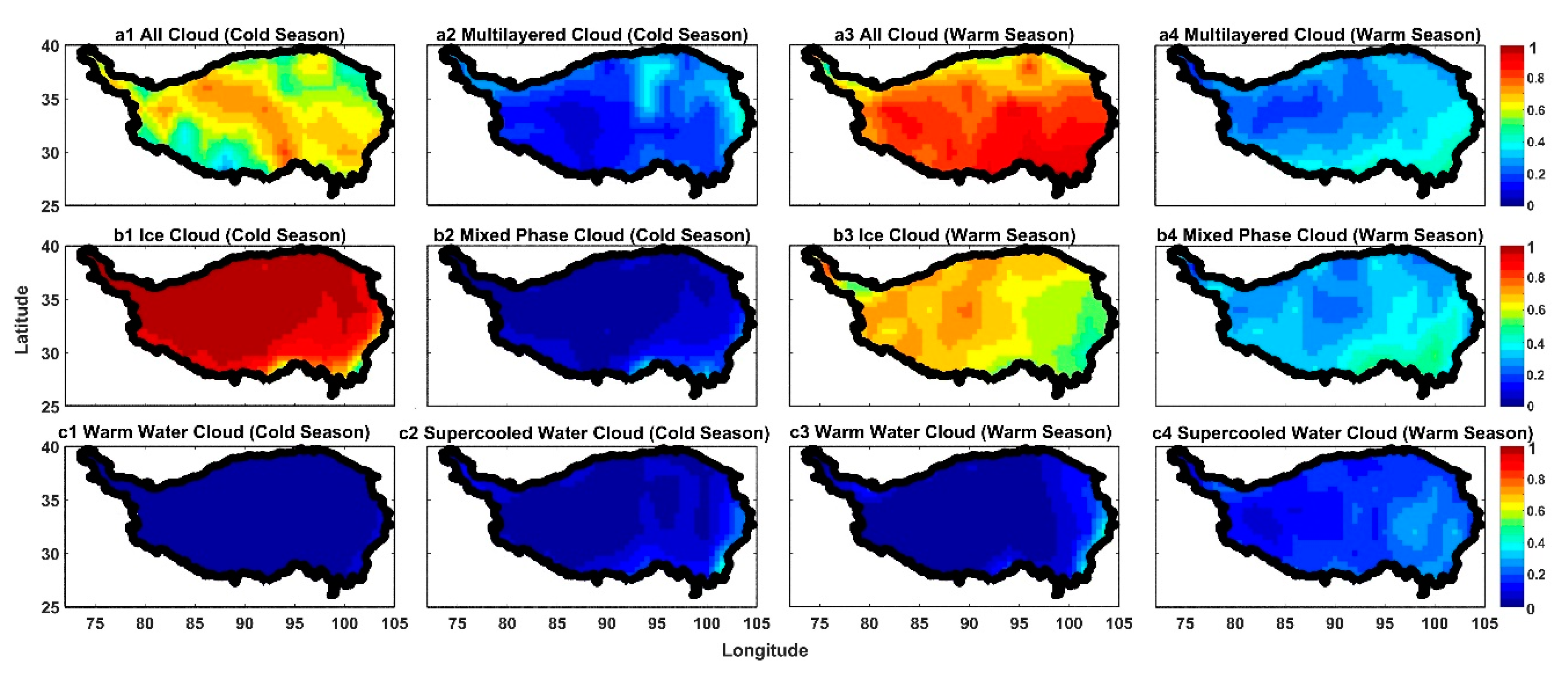
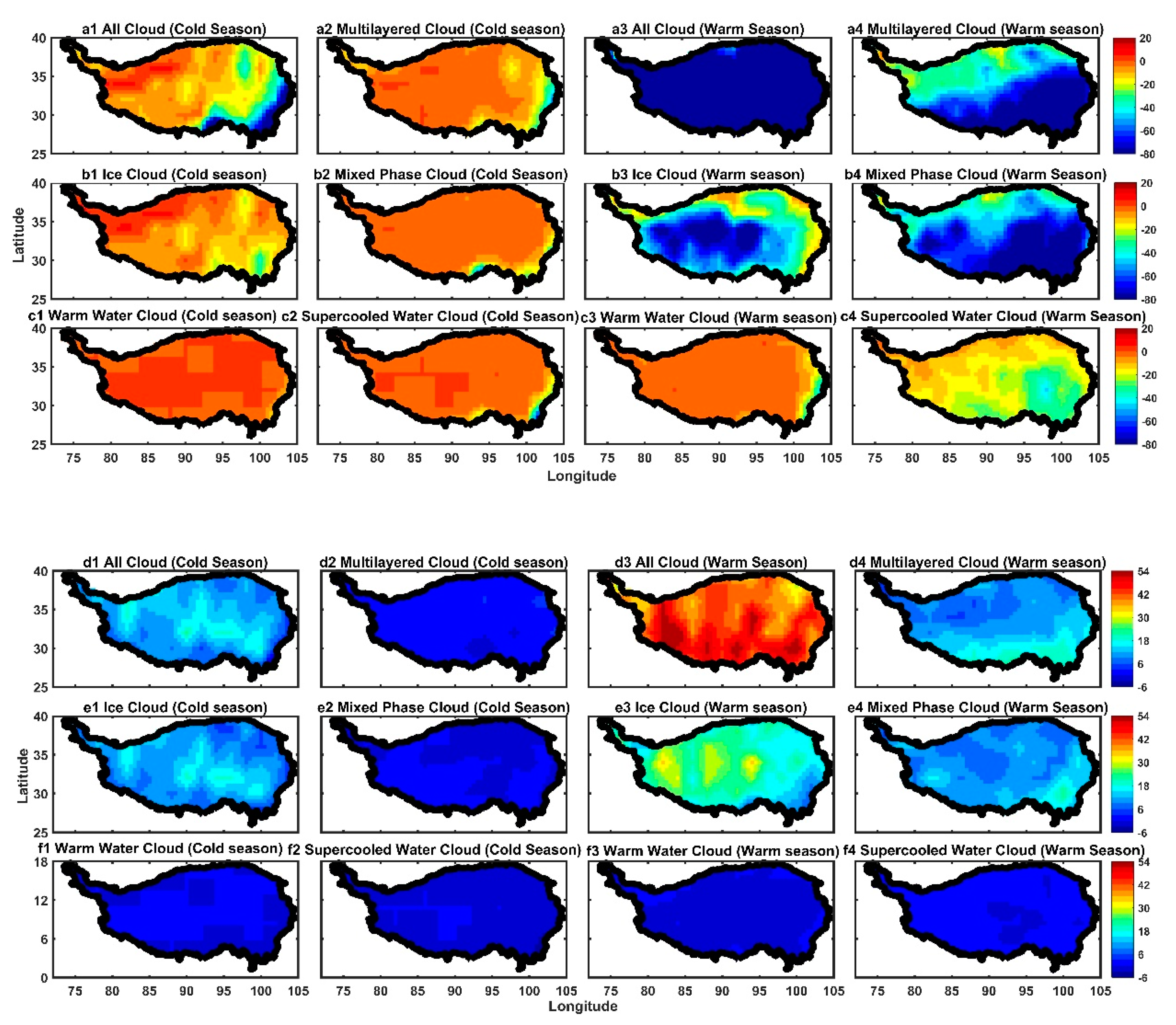
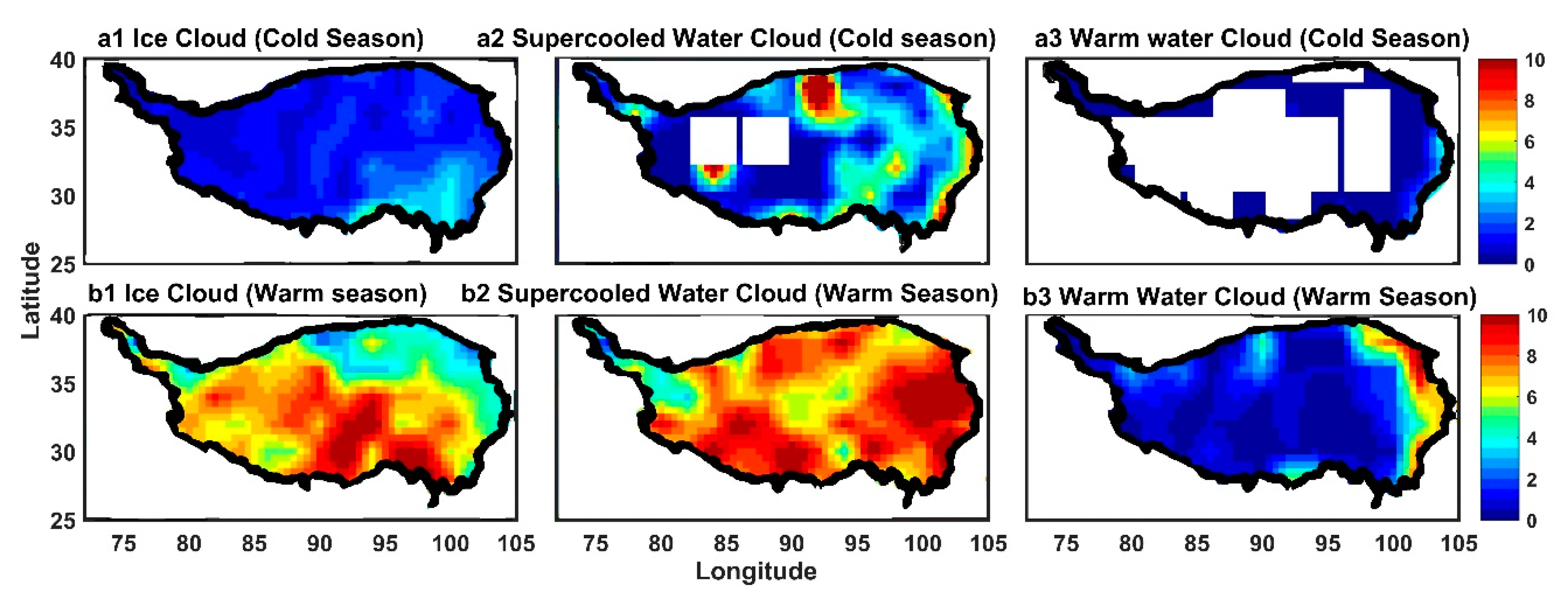
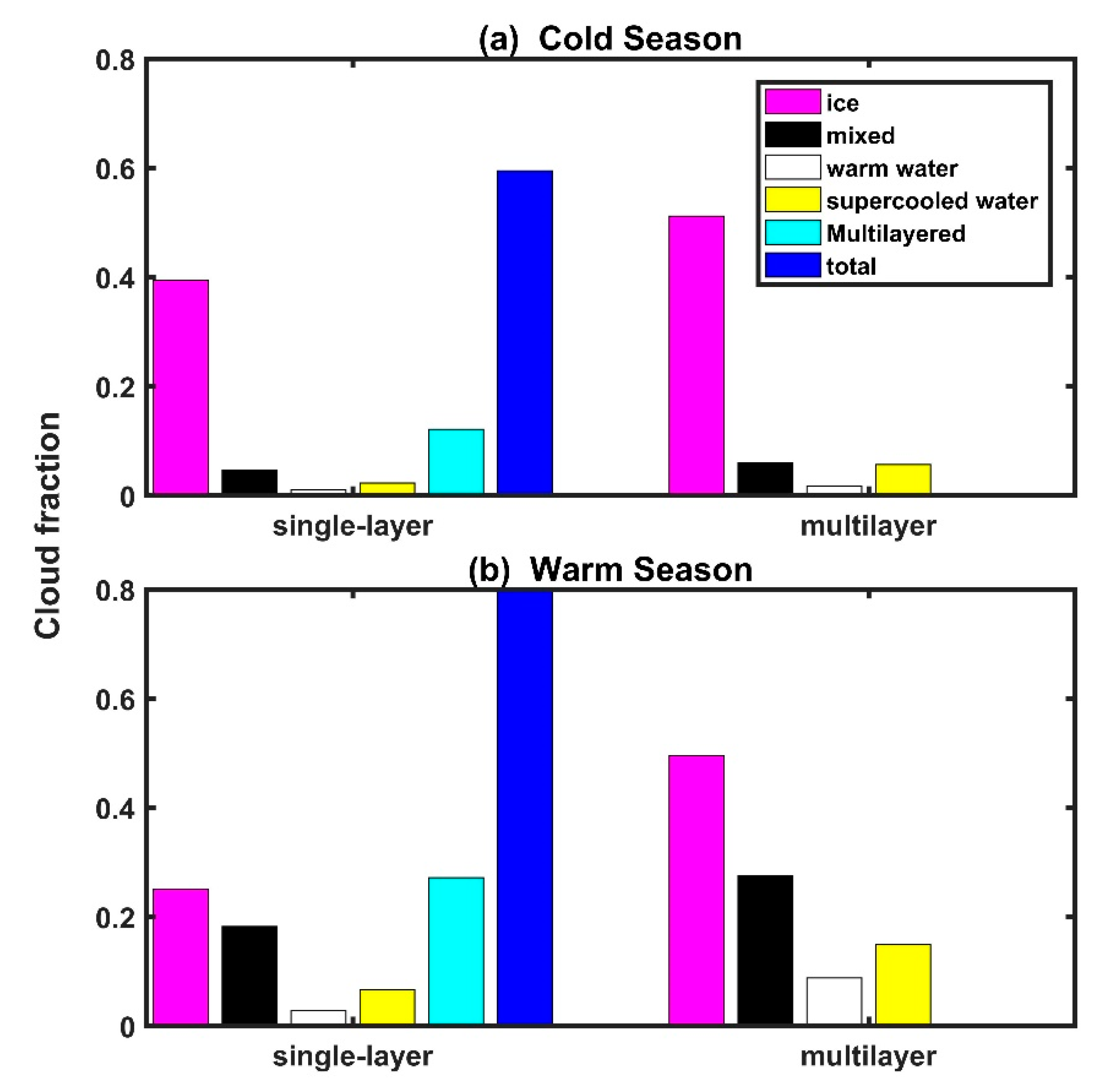


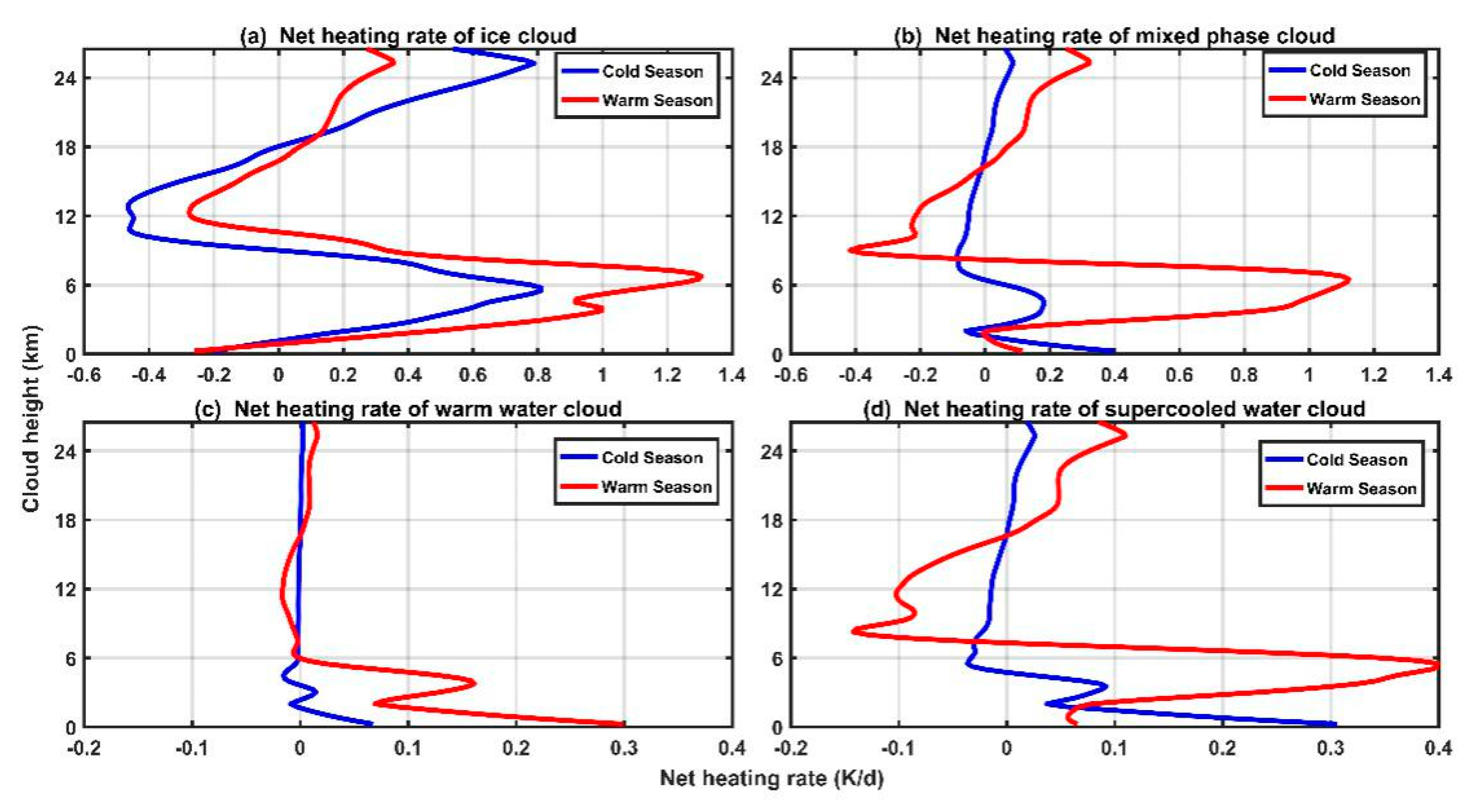

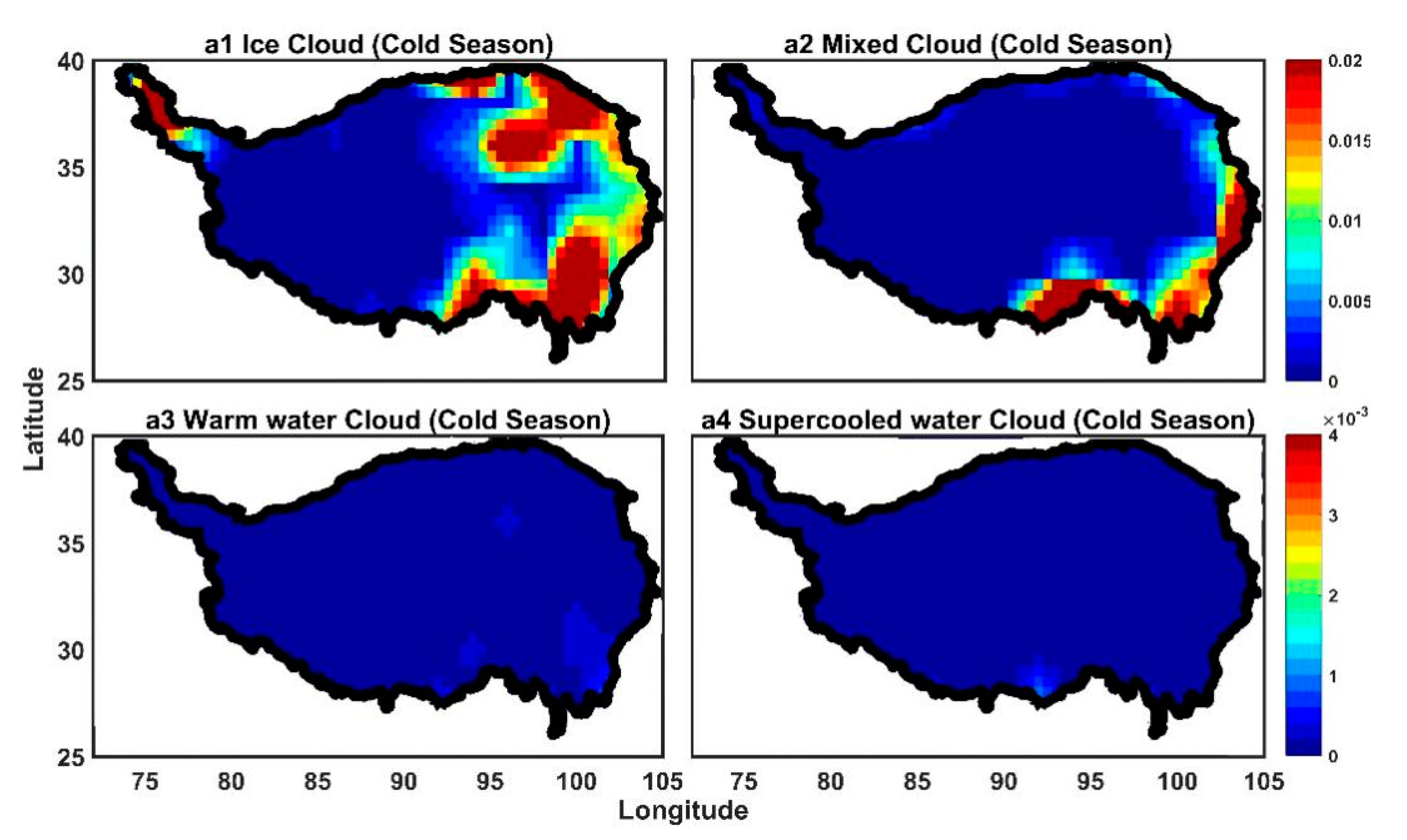

| Platform | Instrument | Specification | Values |
|---|---|---|---|
| CloudSat | CPR | 3200 μm | |
| Attenuation of Clouds | Weak | ||
| Scatter of Cloud particles | Rayleigh/Mie scatter | ||
| CALIPSO | CALIOP | 0.532/1.06 μm | |
| Attenuation of Clouds | Strong | ||
| Scatter of Cloud particles | Mie scatter |
| Data Set | From | Primary Variables | Values |
|---|---|---|---|
| 2B-CLDCLASS-LIDAR | CloudSat/CALIPSO | Cloudlayer | 0–10 |
| CloudPhase | 1–3 | ||
| 2B-FLXHR-LIDAR | CloudSat/CALIPSO | QR | −2 Kd−1–2 K d−1 |
| TOACRE | 0–1500 W m−2 | ||
| BOACRE | 0–1500 W m−2 | ||
| 2C-PRECIP-COLUMN | CloudSat | Precip_flag | 0–9 |
| ECMWF-AUX | AN-ECMWF | Pressure | ~–999 |
| Temperature | ~–999 | ||
| Specific_humidity | ~–999 |
Publisher’s Note: MDPI stays neutral with regard to jurisdictional claims in published maps and institutional affiliations. |
© 2021 by the authors. Licensee MDPI, Basel, Switzerland. This article is an open access article distributed under the terms and conditions of the Creative Commons Attribution (CC BY) license (http://creativecommons.org/licenses/by/4.0/).
Share and Cite
Wang, J.; Jian, B.; Wang, G.; Zhao, Y.; Li, Y.; Letu, H.; Zhang, M.; Li, J. Climatology of Cloud Phase, Cloud Radiative Effects and Precipitation Properties over the Tibetan Plateau. Remote Sens. 2021, 13, 363. https://doi.org/10.3390/rs13030363
Wang J, Jian B, Wang G, Zhao Y, Li Y, Letu H, Zhang M, Li J. Climatology of Cloud Phase, Cloud Radiative Effects and Precipitation Properties over the Tibetan Plateau. Remote Sensing. 2021; 13(3):363. https://doi.org/10.3390/rs13030363
Chicago/Turabian StyleWang, Jing, Bida Jian, Guoyin Wang, Yuxin Zhao, Yarong Li, Husi Letu, Min Zhang, and Jiming Li. 2021. "Climatology of Cloud Phase, Cloud Radiative Effects and Precipitation Properties over the Tibetan Plateau" Remote Sensing 13, no. 3: 363. https://doi.org/10.3390/rs13030363
APA StyleWang, J., Jian, B., Wang, G., Zhao, Y., Li, Y., Letu, H., Zhang, M., & Li, J. (2021). Climatology of Cloud Phase, Cloud Radiative Effects and Precipitation Properties over the Tibetan Plateau. Remote Sensing, 13(3), 363. https://doi.org/10.3390/rs13030363




